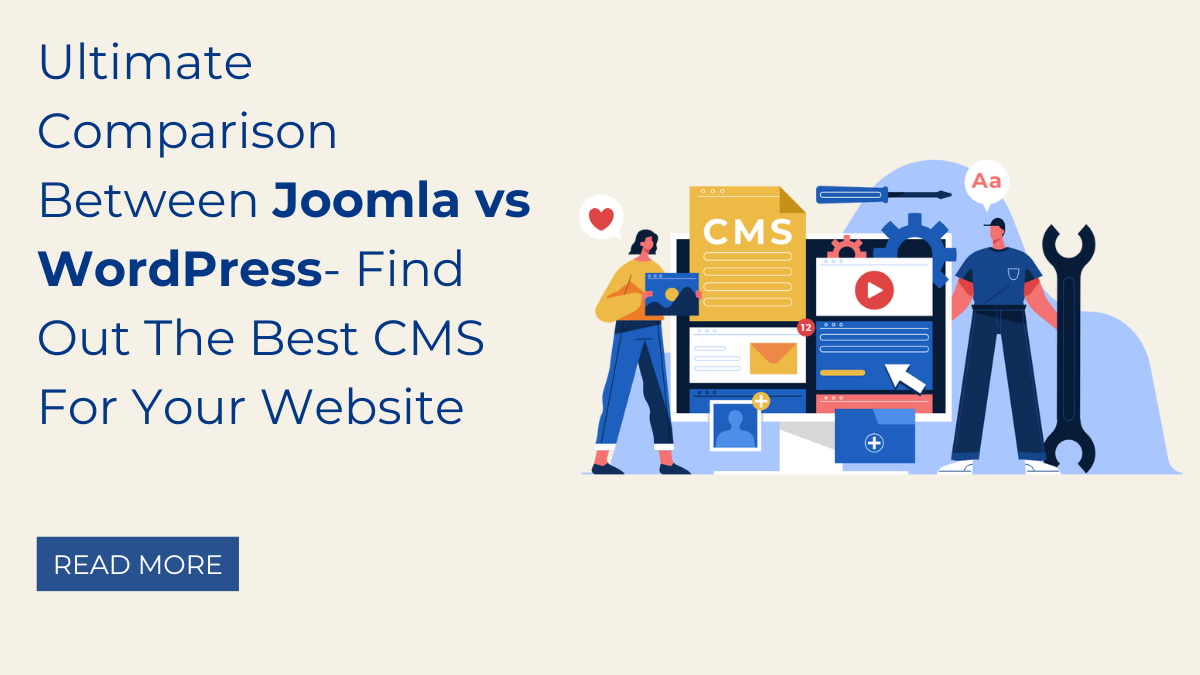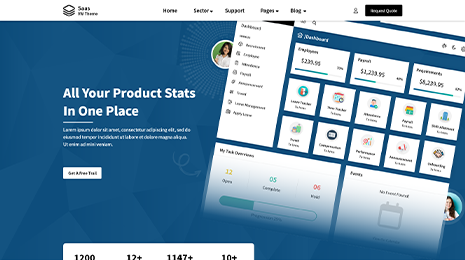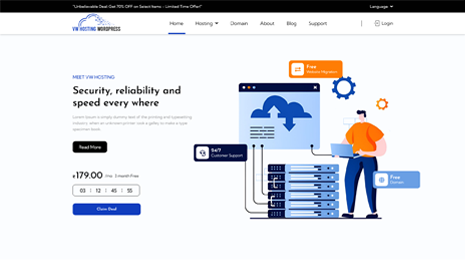Introduction:
Two of the most commonly used content management systems (CMS) available today are Joomla vs WordPress. Being able to choose the CMS platform that best meets your needs will help anyone create a successful website because these platforms offer various yet equally strong web development capabilities.
Remember that finishing your website can be made simpler and more quickly by starting with the appropriate toolset. You will know more clearly at the completion of this comparison which platform will give your website the capabilities it requires.
The Overall Statistics of Joomla vs. WordPress:
Currently, WordPress controls 64.5% of the market and runs 40.6% of all websites. Similar to Joomla, it may be used and modified by web developers under the terms of the GNU General Public Licence.
The Joomla content management system was first intended to be used for building portal-style websites with membership and login forms. Currently, more than 4 million websites across multiple markets use it.
Around 2-3% of websites are powered by Joomla, an open-source, free content management system. With 3-4%% of the market at the moment, it is the second-most-used CMS, behind WordPress.
WordPress, on the other hand, was originally intended to be a blogging platform. WordPress is a content management system that is open-source and free, has undergone ongoing improvement, and currently supports websites of all shapes and sizes.
Some excellent examples of WordPress-built websites are the PlayStation Blog, Whitehouse.gov, and Sony Music.
Which one is better, Joomla vs WordPress:
The main difference between WordPress and Joomla is that WordPress is more user-friendly and requires less technical expertise, whereas Joomla is more flexible but has a longer learning curve. Conversely, WordPress boasts an abundance of plugins that extend its features.
1. Appearance and User-Friendliness:
Regarding availability, functionality, and usability, we shall contrast the themes and extensions supplied by Joomla vs WordPress.
WordPress
More than 58,000 premium and free plugins with features like greater safety, additional possibilities for customization, and analytics for the website are available on the platform.
All you have to do to install a plugin is go to Plugins → Add New. Next, look for the plugin you want to use and select Install → Activate.
But installing third-party add-ons requires manual labor and requires downloading the plugin file either personally or using an FTP client.
Regarding web design, the Premium WordPress themes catalogue offers more than 8,000 free and premium themes, and there are plenty of additional options available on other external marketplaces.
Although the platform offers an interface to customise an installed theme, the ability to customise is typically restricted to specific themes. For more extensive customization options, users are able to download a page builder such as Elementor, Beaver Builder, or Divi Builder or alter the theme’s CSS code. Sadly, WordPress allows only one active theme to be used at once.
Joomla:
Around 8,000 extensions are available in Joomla’s official library. This platform comes with an immense amount of already-built-in features in addition to these extra ones.
In the Cache Settings section, select either Progressive or Conservative Caching.
In contrast with WordPress, installing a Joomla plugin requires additional procedures. This is a result of the admin dashboard’s inability to directly access the extension’s directory. Users must manually upload the extension to the setup page after downloading it from the directory.
Joomla has two different template kinds for its appearance: front-end templates and the back end themes. Users that want more options can visit sources from third parties like ThemeForest and JoomShopper, as the platform does not have an official design directory.
2. Best Search Engine Optimization Results:
Using SEO techniques may increase your website’s position in search engine results pages (SERPs). This section will go over the built-in functionality and extra addons that both Joomla vs WordPress provide to help with SEO.
WordPress:
Basic SEO abilities provided with WordPress SEO Optimization checklist include picture alt text, permalinks, and meta tags. The majority of themes, whether created by WordPress and other developers, also provide SEO functionality through the use of a page-building plugin and the WordPress editor.
To assist with search engine optimization, a plethora of powerful SEO plugins are now accessible. Yoast SEO employs the traffic light system, for instance, to enhance page ranking results. Readability evaluations, keyword optimization, and recommendations for internal links are a few of the guidance signs.
For measuring traffic, external and internal links, and marketing activities, WordPress also offers a plethora of statistics and tracking functionality plugins. MonsterInsights and Analytify are two of the most widely used analytics plugins.
Joomla:
Joomla has several good built-in SEO features. Users are able to enable search engine-friendly URLs by removing index.Php from their website addresses, adding a.html suffix to the URL, and including site names in page titles using the SEO options found in the global configuration.
Utilise a page builder like Quix or an SEO extension like EFSEO if you want more sophisticated SEO capabilities. Quix provides a page-level and website-level optimization tool called Quiz Rank, whereas EFSEO gives you control over the metadata of your website from both the front and back ends.
Unfortunately, extensive technical knowledge is needed for proper on-site optimization for Joomla sites. It could take more time for beginners to grasp these tools’ layout and settings
3. Best Content Management System Platform:
This part will cover managing website material and user access using WordPress and Joomla, in addition to the blogging functionality of the system.
WordPress:
WordPress was first created with blogging in mind. As a result, it features a strong system for handling many different files of every kind and a substantial volume of content.
It was already simple to make pages and postings with the Classic Editor before Gutenberg became the standard editor.
Furthermore, though requiring no code at all, Gutenberg continues to accept HTML for advanced customization.
WordPress has two different page types: static and dynamic. The former is used to hold blog content. When generating a post, you can choose a page type and employ WordPress taxonomy to organize articles and pages.
Six standard user roles are provided by the CMS, which simplifies the management of access and limits on your website. Plugins, a lot of which are free, allow you to extend the user management features and add new user groups.
Joomla:
The appearance of the website content is determined by the three different page types available in Joomla: single format, category blog, and custom module. As was previously indicated, before you can submit an article, you need to establish a category.
The platform comes with a built-in TinyMCE. what-you-see-is-what-you-get (WYSIWYG) editor that resembles WordPress’s Classic Editor. Installing editing extensions is another way to facilitate template modification.
Regretfully, Joomla lacks an integrated taxonomy content system. Installing a content systems extension is required, or you can create one from scratch, which might be difficult and time-consuming.
The positive aspect is that user management is robust with Joomla. It includes a user activity log to help track any actions taken by specific IP addresses on your online presence, as well as a broad restriction of access for page limiting.
4. Differences Of Official Support:
One of the most important things to take into account when choosing the finest CMS to utilize is having a connection to reliable assistance. The kind of help both platforms offer their users and the accessibility of their support channels will be discussed in this section.
WordPress:
As WordPress is a community-driven platform, it lacks live support. In spite of this, it features active, free support discussion boards with individuals ranging from beginner WordPress users to experts.
There are many developers available for hiring on independent contractor portals such as Upwork and Toptal, should you require on-the-job training. Because so many individuals utilize this platform, hiring a developer for the internet to maintain your website is simple and reasonably priced.
Joomla :
Joomla’s help channel is an active community forum. There are also a good number of online lessons and suggestions for improvement.
Unfortunately, compared to WordPress, finding an expert to help with technical problems can be more difficult and costly. For example, the assistance subscriptions from Joomla Department, a third-party business, range in cost from $39 to $299 a month.
5. See Which One Has The Best Security:
This section will examine the security features, such as integrated instruments and security extensions, that both platforms offer to their customers.
WordPress
WordPress versions 3.7 and higher are guaranteed to receive security maintenance updates for all websites. Version 5.5 and above offer automatic upgrades for the two plugins and themes.
WordPress security Plugin offer further safety measures. Customizing your security plugins is up to you, but it could backfire when you cannot determine how to properly set them up correctly, don’t update them frequently, or install a bad plugin. Astra reports that 56% of hacking attacks in 2019 were caused by plugins.
Joomla
Joomla is less susceptible to cyberattacks than WordPress because it is not as widely used as its rival. But in order to fend off bots, it continues to provide its consumers with integrated security features like Google ReCAPTCHA and two-factor authentication (2FA).
Joomla makes sure your website complies with GDPR, enabling you to create cookies depending on visitor consent.
6. Best Ease of Use between Joomla vs WordPress:
This section addresses the administrator area’s navigation, the installation procedure, and the general learning curve for both platforms.
WordPress
A simple-click WordPress installer is a feature of many hosting companies’ hosting plans because WordPress is currently the most popular content management system. It’s also simple to locate WordPress themes and plugins, in addition to hosting services, which are typically included with this content management system.
Examine the control panel as an additional item. People with little background in technology won’t need to spend much time learning what each parameter achieves because it is very beginner-friendly.
There is no complicated navigation, and tasks only require two clicks to complete. To create a new blog post, for instance, all you need to do is go to Posts and select Create New.
Joomla:
Similar to WordPress, a sizable number of CMS hosting companies provide web hosting tailored to Joomla or come with an installation that only needs to be clicked. An extensive collection of extensions and themes, domain names, and servers optimized for Joomla are included in Holsinger’s Joomla hosting packages, for instance.
Unfortunately, Joomla’s control panel is not user-friendly for novices because it is rife with complex phrases related to website building. The platform’s navigation system tends to become even more complex due to the multitude of administrative pages and options.
Joomla uses tools like page-building addons to make up for its complicated user interface. It also has an abundance of friendly beginner classes and forums.
FAQ:
- Which kind of website functions best with Joomla:
For eCommerce websites and medium-sized to large businesses, which frequently need higher-level functionality than other website builders, Joomla works well. A wide variety of features are available to users of this online content management system (CMS), such as multilingual support, multimedia uploading, user registration, and third-party extensions and plugins.
- Is Joomla suitable for beginners:
Although Joomla could have a higher learning curve than other builders of websites like WordPress, it might be an excellent choice for novices. Nonetheless, Joomla is an increasingly popular choice for more intricate websites and online applications because of its flexibility and scalability.
Conclusion:
WordPress could possibly be easier to use if you don’t know much about technology. In addition to being more user-friendly for beginners, it offers a large assortment of themes and plugins that can be used to increase the functionality and personalization options of your website.
Conversely, for those with technical expertise, Joomla can be a great choice. You may be more creative with the assignment because it comes with additional flexibility and capability right out of the box.
There are number of reasons to choose WordPress over other CMS but you can choose the CMS that will assist you in launching a website quickly if you base your decision on your requirements as well as your level of expertise.



















